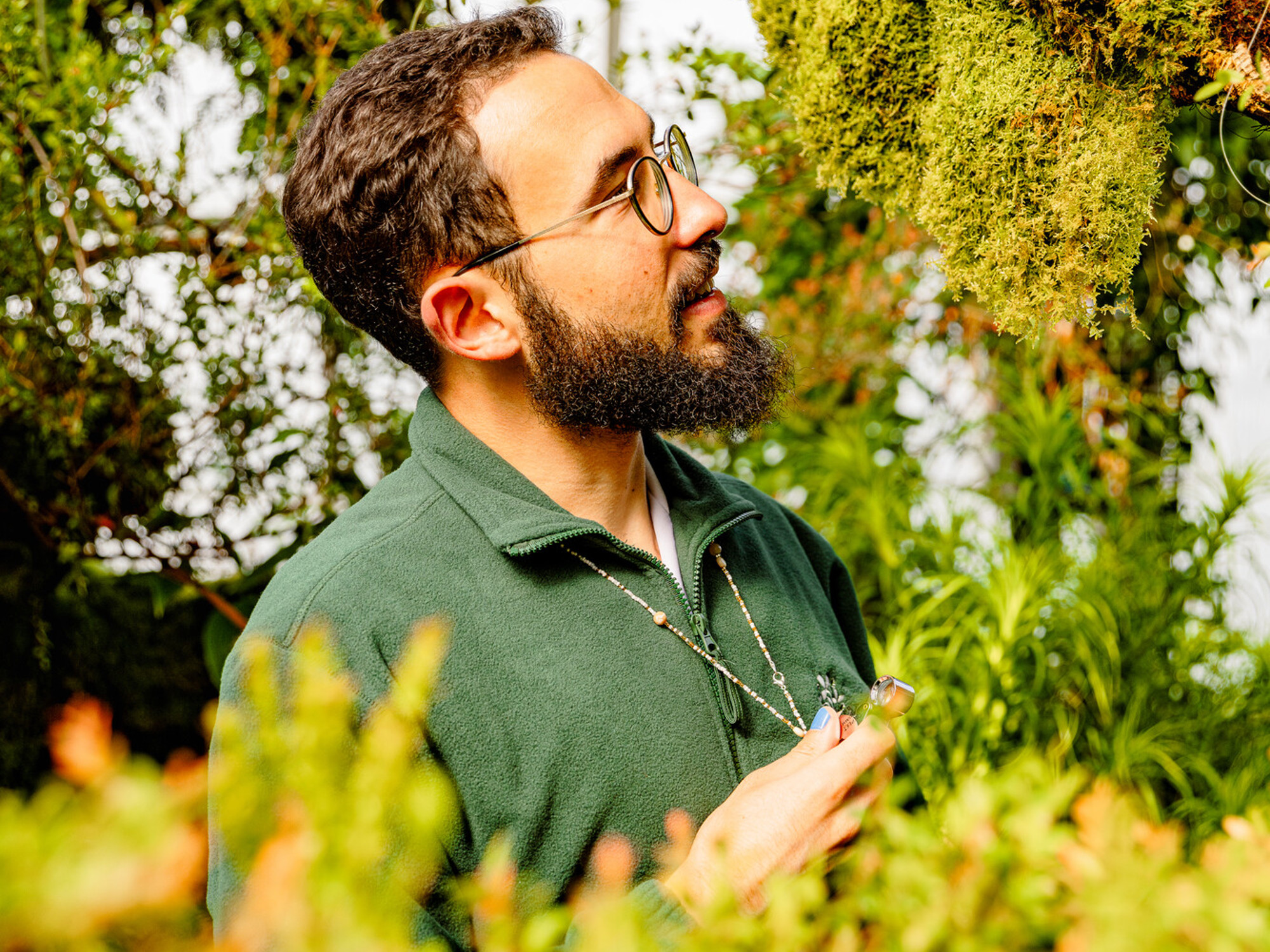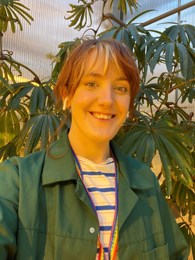
PhD students
-
The Royal Botanic Garden Edinburgh (RBGE) hosts around 30 PhD students working on topics across the range of the Garden’s interests, from taxonomic and biogeography to genomics, conservation, horticulture and plant humanities.
Our students make use of the exceptional Living Collections, Herbarium, Library and laboratories.
Getting a place
PhD students based at RBGE are registered at a range of universities across the UK and worldwide, and follow the entry requirements and assessment procedures of the university they are registered with. Supervisors at the degree-awarding university may be very involved in the project, or may take a more back-seat role.
RBGE staff should be able to advise on university partners for self-designed projects. If you have an idea you would like to work on, contact a staff member to discuss the project.
PhDs available at RBGE are also online at listed at Find A PhD.
Funding
Information on funding for prospective University of Edinburgh students can be found here.
RBGE students from overseas are often are funded by scholarships from their home countries, but many of our students are registered at the University of Edinburgh through their Doctoral training Programs (E5 and EastBio) or Darwin Fellowships.
Our current students
You can find out more about some of our current PhD students and their projects below:

I am a PhD student studying the impact of the Garden’s living and preserved collections on the climate and biodiversity crises. This project is a collaboration between the Royal Botanic Garden Edinburgh and The University of Edinburgh.
The project will critically examine the way that RBGE’s collection is used to impact policy and practice nationally and internationally, and hopes ultimately to provide recommendations on how RBGE's collection can be used to impact conservation and climate outcomes more effectively, contributing to the wider discourse and practice surrounding environmental policymaking and the crucial role botanic garden collections can play in this.
Having previously completed an interdisciplinary MSc in Conservation Studies at the University of St Andrews, I am interested in science communication and how we can ensure that conservation work is being conducted in the most effective and appropriate way.
I am a passionate speaker and conservation educator, and I work for both the Royal Zoological Society of Scotland and the Royal Botanic Garden Edinburgh. I am also the creator of Pangolin: The Conservation Podcast, a show which celebrates the stories of underappreciated species and amplifies the voices of underrepresented groups.

I am a botanist from a small town in the Colombian Andes, where I grew up. I did my bachelor's in biology at the University of Antioquia (Colombia), focusing on plant taxonomy. In 2023, I obtained an MSc in Biodiversity and Systematics from the University of Gothenburg (Sweden), where I specialized in plant systematics and studied the “Evolution of flower symmetry and the phylogeny of the genus Posoqueria (Rubiaceae).
Currently, I am a member of Kidner’s Lab at RBGE and the University of Edinburgh. In my PhD project, I am exploring the diversification patterns within the genus Begonia, one of the most species-rich genera, with over 2.100 species. Specifically, I investigate how species evolve and adapt in the unique ecosystems of the Neotropical Andes.
As a study system, I selected the Neotropical section Casparya, which has about 50 species. The initial plan is to implement two main approaches in my research. First, a population genomics analysis using NGS data will be conducted to understand how endemic species with small populations split, and how widely distributed species with large populations maintain coherence. Second, I will characterize reticulate evolution patterns in Casparya. The systematics of Begonia and its section Casparya are still based on Sanger approaches. I will generate an updated, NGS phylogeny of the section, and to place the results in a general phylogenetic context, I will include in the analysis species from the sister section Ruizopavonia and at least one species from every Neotropical Begonia section.
Photo: Fieldwork in 2024 in “El Páramo del Sol” at 3,500 masl (Antioquia, Colombia)

Africa’s Exceptional Monodominant Forest
I am a PhD student at RGBE and the University of Edinburgh studying monodominant forests in the Congo Basin. Tropical forests are the most diverse terrestrial ecosystems on earth. However, in the forests of central Africa, there is a species of tree, Gilbertiodendron dewevrei, that forms stands in which up to 80% of the trees belong to this one species, overturning every stereotype of plant diversity in the tropics.
My research focuses on examining these exceptional monodominant Gilbertiodendron forests and asking what the current distribution of this forest type is, and how this might change in the future. I am looking at their species composition in comparison to adjacent mixed species forest, mapping out their current extent, and asking whether they are expanding or contracting. I will also look at modelling how their distribution may change in the future, under different climatic conditions, and different trajectories of forest loss. Predicting expansion or contraction of this monodominant forest over the next 50 -100 years will be crucial for modelling the Congo Basin block for carbon storage and biodiversity, as G. dewevrei forest has higher carbon stocks and lower species diversity than mixed species forest.

Phylogenetic, Biogeographic and Ecological Inquiry into Deciduousness
I joined the PhD cohort in 2023, exploring the species-environment relationship in the Chittagong Hill Tracts flora of Bangladesh through niche modelling approach. Later, I refined my research goal to a broader aim of examining trait evolution in flowering plants. The evolution of novel traits (e.g., deciduousness) in plants and their impact on niche and distribution is fundamental to our understanding of the historical assembly of the world’s biomes. My research focuses on tracing the number and geographic context of evolutionary transitions to deciduousness and assessing their ecological drivers through niche modelling and phylogenetic comparative methods. My PhD is funded by the Ministry of Science and Technology, Bangladesh.

I am a field botanist and educator from the Philippines working on phenological forecasts, specifically predicting the impact of climate shifts on the flowering and fruiting times of trees in Southeast Asian islands, starting in 2024.
My research is powered by the Edinburgh Earth, Ecology, and Environment Doctoral Training Partnership (E4 DTP) from the UK Natural Environment Research Council (NERC). I receive integrative mentorship from the Royal Botanic Garden Edinburgh under Southeast Asian flora specialists Dr Mark Hughes and Dr Peter Wilkie, and The University of Edinburgh under plant evolution and biogeography expert Dr Richard Milne.
My fondness of plant resilience traces back to my home country, teeming with plant diversity but regularly threatened by eruptions and typhoons, owing to its Pacific location. My bachelor’s capstone at University of the Philippines Manila found the persistence of invasive alien species in a forest two decades after the Mount Pinatubo eruption, whereas my master’s research at San Francisco State University, California uncovered mismatches between past and present records of flowering and fruiting of tungaw, woody plants in the melastome family.
For my PhD, I explore plant adaptations further by examining how phenological shifts are driven by regional climate patterns such as monsoons and El Niño, and which tree families, forest zones, or islands are most vulnerable. I do so by unlocking data from herbarium specimens, legacy literature, and monitoring plots using meta-analytic, big data, and geospatial analyses, in the hopes of making forest restoration strategies in the region more climate-smart and future-proof.

Unexplored transitions between forests and savannas in Africa
I originally trained as a botanical horticulturist, focusing on using ex-situ plant collections for research and conservation. I joined RBGE in 2018 on the MSc in Biodiversity and Taxonomy of Plants. This was an amazing course and really motivated me to pursue research in tropical environments. My dissertation combined morphometric, ecological and population genomic data to study the taxonomy of the national tree of Brazil (Paubrasilia echinata). Currently I am a PhD candidate in the E4 DTP, where my research consists in exploring the floristic, structural and functional thresholds that are involved in the transitions between forests and savannas. My geographical focus is on Africa where these two environments represent over 60% of the land surface and provide ecosystem services to over 200 million people. Specifically my fieldwork is carried out in Angola, one of the least botanically explored countries in Africa, and which represents a region that will be subjected to strong environmental change in the near future according to prediction from the IPCC. Without ground-truth data, it will not be possible to accurately predict how climate change will impact these two biomes and what the consequences will be for the people that live and depend on these resources.

Exploring the Origin and Evolution of Spiral Phyllotactic Patterns in Vascular Plants
I am a botanist and educationalist currently undertaking a PhD on the evolutionary history of plant spiral patterns. My research involves utilising cutting-edge extant and fossil plant microscopy and histology techniques combined with phylogeny building and ancestral character state analyses to understand the evolution of Fibonacci and other spiral patterns in phyllotaxy (leaves and other lateral organs' arrangement on a stem).

My doctoral research utilises inexpensive do-it-yourself air-sampling devices to capture lichen reproductive structures across field sites within Scotland. The collected material is pooled into composite samples, from which I extract environmental DNA (eDNA) for high throughput metabarcoding.
By combining sequence data with detailed microclimate measurements, I plan to document the phenology and spatial patterns of lichen dispersal and test how these factors influence community assembly. Such knowledge is urgently needed, as many of Scotland’s lichens are threatened by changing land use and climate. Yet, they are often overlooked in conservation planning and frequently lack genetic data in public databases.
Originating from a background in computational biology and field ecology, I aim to create reproducible work that is easy to use and incorporate into current survey methodologies at minimal cost for researchers and conservation practitioners.
Ultimately, the project aims to supply actionable benchmarks for habitat restoration, refine the methodological limits of airborne eDNA surveys, and demonstrate how low-cost technology can aid in biodiversity monitoring of Scottish landscapes.

Do duplicated genes drive morphological diversity?
I am a plant geneticist interested in applying biotechnological methods to new problems. Before starting my PhD, I completed my MBiol at the University of York and further pursued my interest in genetics by working for a plant biotechnology company. The aim of my project in the Kidner group is to utilise CRISPR technology to knock out duplicated genes in several begonia species and assess their morphological impact. This will help us understand how gene functions diverge after duplication. I am mainly based at the King’s Buildings at the University of Edinburgh optimising Begonia tissue culture, transformation and CRISPR editing.

Genetic species delimitation in the Bruneiana Group of Begonia
I started my PhD at the RBGE and the UoE in October 2024. My research focuses on the Bruneiana group of Begonia, which currently includes around 35 species widely distributed across Borneo. Members of this group share several distinctive features, such as nearly symmetrical leaves, simple inflorescences with two or three flowers in each leaf axil, and occasionally flowering from old leaf nodes that resemble “cauliflorous” growth.
Through population-level sampling and genome-scale data, my work aims to explore species boundaries within this complex group and improve our understanding of speciation in Begonia.
I obtained my BSc in Biological Sciences from Northwest A&F University, China, where I studied the feasibility of using quantitative morphological traits in the taxonomy of Zygophyllum and explored the influence of biogeography. During my master’s studies (South China Botanical Garden, Chinese Academy of Sciences), I investigated the evolution of the glucan synthase gene family and developed chromosome localization techniques (FISH) in Avena, examining gene evolution across different ploidy levels.

Floral development and evolution in the Begoniaceae
I began my PhD project in RBGE and the University of Edinburgh in April, 2021. Before I came here, I finished my MSc project in Northwest A&F University in China. My research interests are in floral morphology and development, and the evolution of floral traits. I used to study floral development of Sanguisorba (Rosaceae), floral development and phylogeny of Prunus s.l. (Rosaceae). Impressed by the high morphological diversity of the Begoniaceae, I joined the Begonia Group of RBGE and focused on floral development and evolution of Begoniaceae, after winning a scholarship from the Darwin Trust of UoE. The first paper from my thesis, on the floral development of Hillebrandia sandwicensis, the sister of Begonia, is now published.

I am a Brazilian botanist and researcher with an MSc in Biodiversity and Evolution, a BSc in Biological Sciences, and a Technical diploma in Chemistry. My academic background and professional experience in plant taxonomy, bioinformatics and biogeography inform my strong interest in understanding large-scale patterns of plant diversity, distribution and evolution. I have expertise in developing R packages (Zuanny et al., 2024) and front-end web development, as well as extensive fieldwork in tropical dry forests and rupestrian grasslands, where I have led field teams and had my work recognised on the cover page of a special issue of the Plants, People, Planet scientific journal while implementing a new DRYFLOR protocol. Additionally, I have research experience in tropical rainforest disjunctions and in urban arborisation.
Currently, as part of Tiina Särkinen's team at RBGE, my PhD research investigates the biology of big angiosperm genera - those with more than 500 species. My aim is to explore whether these genera share common biological attributes or evolutionary processes that help explain their exceptional size. I am also investigating if genera represent evolutionarily meaningful units, using the families Solanaceae and Fabaceae as study groups. By integrating data from major plant databases and through collaboration with taxonomic experts worldwide, this project will generate a taxonomically robust and biologically informed overview of the world’s biggest flowering plant genera. These findings will contribute to our understanding of plant diversification and classification, supporting future taxonomic revisions.
Contact details:
